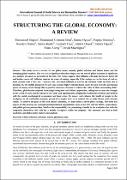| dc.description.abstract | This study covers a review of two global issues, namely; global inflation and labour issues and the emerging global markets. The two are so significant that their impact on the overall global economy is significant in a number of aspects as presented in the text. Our review suggests that inflation will make borrowers better off and lenders worse off. Inflation reduces the value of savings, especially if the savings are in the form of cash or bank account with a very low – interest rate. Too much inflation is bad for the economy while too little also is harmful. So, the middle ground of 2% per year is good, higher inflation harm savers because it erodes purchasing power of money saved though this is good for borrowers because it adjusts the value of their outstanding debts. Therefore, globalization requires increasingly integrated and holistic approaches, taking into account the changes in the world of work and the advent of new risks and opportunities merging the traditional technical and medical with the social, psychological, economical and legal areas. To protect and enhance the health of people in the workplace in the worldwide economy, practical strategies have to be worked out to make decent work become reality. To achieve the goals of the core labour standards, we must utilize a three-pillar strategy. The three key aspects of this strategy are national and international organizations such as the ILO and the WHO, corporations, and public-private partnerships. Much of the responsibility for promoting a health in the workplace lies with the companies themselves; this calls for a healthy workplace within the company. The outcomes are vital to both academics and global policy makers and analysts. | en_US |

